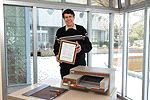Inkjet & Digital Printing
Heavy Chemistry helps Xerox Scientist Reach Patent Milestone

Wednesday 14. January 2009 - Many scientists claim to have 'eureka' moments, but rarely at the age of 12. However that's when Xerox Corporation (NYSE: XRX) scientist Peter Kazmaier first felt the thrill of creating new molecular structures - while using his first chemistry set.
This fall, Kazmaier experienced another thrill from the scientific community: the receipt of his 100th U.S. patent, a rare achievement that puts him among the ranks of Xerox’s most inventive scientists, and only the fifth Canadian scientist at Xerox to accomplish this feat.
His 100th patent, No. 7,432,027 is entitled “Dual-layer protected transient document.” It is a member of a patent portfolio that describes ground breaking materials that enable paper that can be re-imaged time and time again. Manager of the New Materials Design group at the Xerox Research Centre of Canada, Kazmaier has been with Xerox since 1979, when he joined the company as a member of the research staff to work on the design and synthesis of novel infrared organic photoreceptor pigments.
“Peter has become an integral part of the fabric that makes up XRCC,” says Hadi Mahabadi, vice president and centre director, Xerox Research Centre Canada. “In addition to his own inventions, he has helped many other researchers and has been instrumental at XRCC in sustaining our culture of innovation in the Xerox labs.”
Kazmaier’s current work is focused on research involving molecular switches, smart materials and nanostructures that enable new types of document media and increase paper functionality. He has more than 60 refereed publications, and one on Stable Free Radical Polymerization has received more than 1,100 citations – a work that was also recognized by the American Chemistry Society who awarded the team the Arthur K. Doolittle Award.
In addition to his work with Xerox, Kazmaier is also Adjunct Professor in the department of Chemistry at Queen’s University in Kingston – a role he takes very seriously for the opportunity to help students appreciate the beauty and the utility of chemistry.
“I have never lost the sense of wonder and awe that I first experienced when I made a new compound. I still get the sense that I’m looking into God’s toolbox,” says Kazmaier. “It has also been a privilege for me to work with great scientists in both academia and industry. The team work and interaction at a facility like the Xerox Research Centre of Canada provides an exciting venue where you can actually see your inventions come to life.”
For example he would love to see Transient Documents (erasable paper) brought to market. And if Kazmaier doesn’t have a chance to work on the final patent for this invention, perhaps one of his sons may: two of them have chosen science as their vocation.
Prior to beginning his 30 year career at Xerox, Kazmaier completed his undergraduate degree in Honours Chemistry at the University of Calgary. After his first undergraduate year, he was permitted by Professor M. H. Benn to work as a research assistant in the Department of Chemistry at the University of Calgary. Those three summer work terms led to four research publications and convinced Kazmaier that he wanted to continue on to graduate school.
He then went on to complete his Ph.D. in chemistry at Queen’s University in Kingston as a National Research Council (NRC) 1967 Centennial Scholar. He joined the Xerox Research Centre of Canada after completing a year as a Killam Postdoctoral Fellow at the University of British Columbia. In 1991 he worked with Ronald Hoffmann at Cornell University as a visiting scientist. He also contributes to the intellectual property strategy committee at XRCC.
